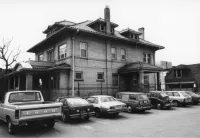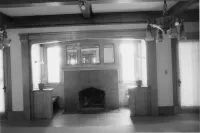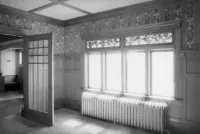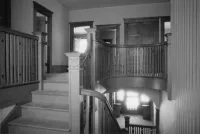Share what you know,
and discover more.
Share what you know,
and discover more.
Oct 03, 1984
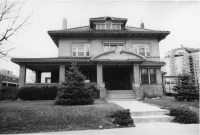
-

- Charmaine Bantugan
National Register of Historic Places - Pierce-Haley House (Haley-Cummings House)
Statement of Significant: Located in what was once the impressive residential area known as Quality Hill, the Haley House remains as one of the substantial houses of the late 19th-early 20th century era along Grant Street that composed this well-known neighborhood. Built in 1910, the house exhibits a rather typical Foursquare design, which masks an interior marked by a wealth of detailing popular of the era, including exceptional examples of decoration influenced by the Arts and Crafts Movement. Until 1984, the residence had been owned and occupied by only two families, the Haleys and the Cummings. The house was built for speculation by Robert Ansel Pierce and Thaddeus A. Gage (who was probably Pierce's father-in-law). According to the Denver City Directory, Pierce was a civil engineer for several coal companies from 1904 until 1911, and was a practicing architect from 1912 until 1923. He was employed as a mining engineer from 1924 until 1935, the last listing for his name. The plan Pierce chose for the house was in no way original. There were already many homes in Denver of the Foursquare type, a style consistent with if not directly derived from ideas developed by promoters of the Arts and Crafts Movement, who called for functional, unadorned architecture. After the turn of the century, Craftsman- inspired California bungalows and Foursquares were built throughout Denver, which in many cases were made affordable to the working class. However, Foursquares were not built only for the working class. The Haley House, for example was large and costly. Ornamentation could be luxurious, although characterized by a simplicity of design and freedom from unnecessary formality. Recognized was the decorative value of built-in elements, the charm of cosy nooks, and the warmth and beauty attained through the liberal use of wood. Pierce was not completely consistent in the use of Craftsman ideas, however. He added a few "Colonial" touches, a style popular during the period. His design called for blending the straight lines of the Craftsman style with the use of such treatments as Palladian-type windows, the Colonial banister at the second floor of the main facade, and the Colonial pediment of the portico over the entry. The house was originally purchased by Ora Ben Haley, who had already made a good bit of Wyoming and Colorado history before he moved to Denver and bought R. A. Pierce's ready- made home. A self-made millionaire of the nineteenth century mold, he started in Denver in 1868 as a bullwhacker and went on to become a "cattle king." He made his name mainly in Wyoming and northwestern Colorado where he dominated the range-cattle business for three decades. In Wyoming he was elected to the state legislature and was instrumental in the founding of what became the Wyoming Stock and Wool Growers Association, an immensely important institution in that state. In its early days, however, the Association was mostly composed of cattle ranchers and functioned largely as a group to block homesteaders, rustlers, and sheepment from their territory by whatever means were most effective.
National Register of Historic Places - Pierce-Haley House (Haley-Cummings House)
Statement of Significant: Located in what was once the impressive residential area known as Quality Hill, the Haley House remains as one of the substantial houses of the late 19th-early 20th century era along Grant Street that composed this well-known neighborhood. Built in 1910, the house exhibits a rather typical Foursquare design, which masks an interior marked by a wealth of detailing popular of the era, including exceptional examples of decoration influenced by the Arts and Crafts Movement. Until 1984, the residence had been owned and occupied by only two families, the Haleys and the Cummings. The house was built for speculation by Robert Ansel Pierce and Thaddeus A. Gage (who was probably Pierce's father-in-law). According to the Denver City Directory, Pierce was a civil engineer for several coal companies from 1904 until 1911, and was a practicing architect from 1912 until 1923. He was employed as a mining engineer from 1924 until 1935, the last listing for his name. The plan Pierce chose for the house was in no way original. There were already many homes in Denver of the Foursquare type, a style consistent with if not directly derived from ideas developed by promoters of the Arts and Crafts Movement, who called for functional, unadorned architecture. After the turn of the century, Craftsman- inspired California bungalows and Foursquares were built throughout Denver, which in many cases were made affordable to the working class. However, Foursquares were not built only for the working class. The Haley House, for example was large and costly. Ornamentation could be luxurious, although characterized by a simplicity of design and freedom from unnecessary formality. Recognized was the decorative value of built-in elements, the charm of cosy nooks, and the warmth and beauty attained through the liberal use of wood. Pierce was not completely consistent in the use of Craftsman ideas, however. He added a few "Colonial" touches, a style popular during the period. His design called for blending the straight lines of the Craftsman style with the use of such treatments as Palladian-type windows, the Colonial banister at the second floor of the main facade, and the Colonial pediment of the portico over the entry. The house was originally purchased by Ora Ben Haley, who had already made a good bit of Wyoming and Colorado history before he moved to Denver and bought R. A. Pierce's ready- made home. A self-made millionaire of the nineteenth century mold, he started in Denver in 1868 as a bullwhacker and went on to become a "cattle king." He made his name mainly in Wyoming and northwestern Colorado where he dominated the range-cattle business for three decades. In Wyoming he was elected to the state legislature and was instrumental in the founding of what became the Wyoming Stock and Wool Growers Association, an immensely important institution in that state. In its early days, however, the Association was mostly composed of cattle ranchers and functioned largely as a group to block homesteaders, rustlers, and sheepment from their territory by whatever means were most effective.
Oct 03, 1984
National Register of Historic Places - Pierce-Haley House (Haley-Cummings House)
Statement of Significant:Located in what was once the impressive residential area known as Quality Hill, the Haley House remains as one of the substantial houses of the late 19th-early 20th century era along Grant Street that composed this well-known neighborhood. Built in 1910, the house exhibits a rather typical Foursquare design, which masks an interior marked by a wealth of detailing popular of the era, including exceptional examples of decoration influenced by the Arts and Crafts Movement.
Until 1984, the residence had been owned and occupied by only two families, the Haleys and the Cummings. The house was built for speculation by Robert Ansel Pierce and Thaddeus A. Gage (who was probably Pierce's father-in-law). According to the Denver City Directory, Pierce was a civil engineer for several coal companies from 1904 until 1911, and was a practicing architect from 1912 until 1923. He was employed as a mining engineer from 1924 until 1935, the last listing for his name.
The plan Pierce chose for the house was in no way original. There were already many homes in Denver of the Foursquare type, a style consistent with if not directly derived from ideas developed by promoters of the Arts and Crafts Movement, who called for functional, unadorned architecture. After the turn of the century, Craftsman- inspired California bungalows and Foursquares were built throughout Denver, which in many cases were made affordable to the working class.
However, Foursquares were not built only for the working class. The Haley House, for example was large and costly. Ornamentation could be luxurious, although characterized by a simplicity of design and freedom from unnecessary formality. Recognized was the decorative value of built-in elements, the charm of cosy nooks, and the warmth and beauty attained through the liberal use of wood.
Pierce was not completely consistent in the use of Craftsman ideas, however. He added a few "Colonial" touches, a style popular during the period. His design called for blending the straight lines of the Craftsman style with the use of such treatments as Palladian-type windows, the Colonial banister at the second floor of the main facade, and the Colonial pediment of the portico over the entry.
The house was originally purchased by Ora Ben Haley, who had already made a good bit of Wyoming and Colorado history before he moved to Denver and bought R. A. Pierce's ready- made home. A self-made millionaire of the nineteenth century mold, he started in Denver in 1868 as a bullwhacker and went on to become a "cattle king." He made his name mainly in Wyoming and northwestern Colorado where he dominated the range-cattle business for three decades. In Wyoming he was elected to the state legislature and was instrumental in the founding of what became the Wyoming Stock and Wool Growers Association, an immensely important institution in that state. In its early days, however, the Association was mostly composed of cattle ranchers and functioned largely as a group to block homesteaders, rustlers, and sheepment from their territory by whatever means were most effective.
Posted Date
Aug 01, 2023
Historical Record Date
Oct 03, 1984
Source Name
National Register of Historic Places
Source Website
Delete Story
Are you sure you want to delete this story?


